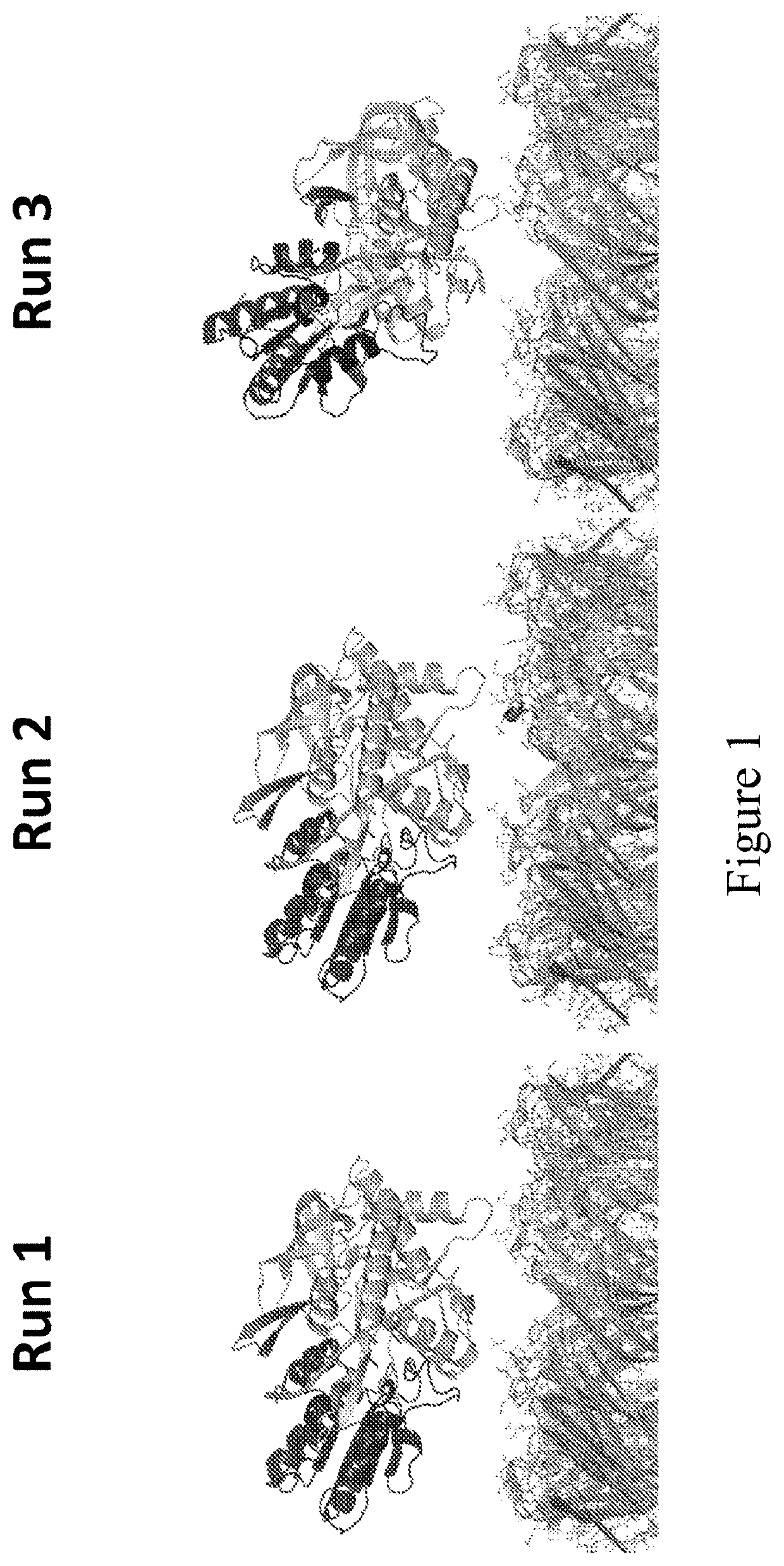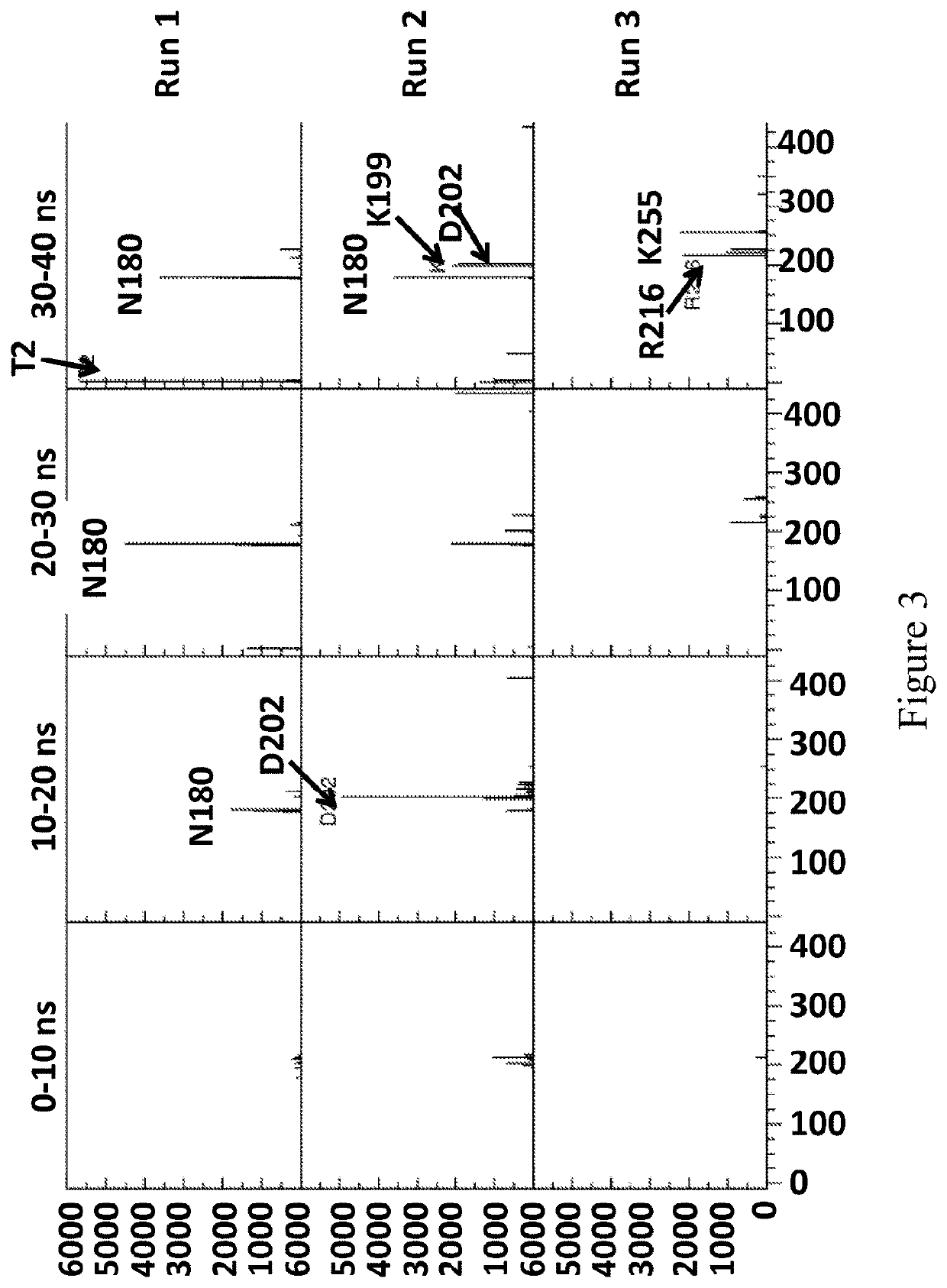Modified enzymes
a technology of helicases and enzymes, applied in the field of modified dda helicases, can solve problems such as problems such as slipping forward
- Summary
- Abstract
- Description
- Claims
- Application Information
AI Technical Summary
Benefits of technology
Problems solved by technology
Method used
Image
Examples
example 1
[0769]This example describes the simulations which were run to investigate the interaction between MspA-(G75S / G77S / L88N / D90N / D91N / D118R / Q126R / D134R / E139K)8 (SEQ ID NO: 2 with mutations G75S / G77S / L88N / D90N / D91N / D118R / Q126R / D134R / E139K=MspA mutant 1) or MspA-((Del-L74 / G75 / D118 / L119)D56N / E59R / L88N / D90N / D91N / Q126R / D134R / E139K)8 (SEQ ID NO: 2 with mutations D56N / E59R / L88N / D90N / D91N / Q126R / D134R / E139K and deletion of the amino acids L74 / G75 / D118 / L119=MspA mutant 2) with T4 Dda-E94C / A360C / C109A / C136A (SEQ ID NO: 8 with mutations E94C / A360C / C114A / C171A / C421D)=enzyme mutant 1a).
[0770]Simulations were performed using the GROMACS package version 4.0.5, with the GROMOS 53a6 forcefield and the SPC water model.
[0771]The MspA mutant 1 and MspA mutant 2 models were based on the crystal structure of MspA found in the protein data bank, accession code IUUN. The relevant mutations were made using PyMOL, and in the case of MspA mutant 2 the residues L74 / G75 / D118 / L119 were deleted from the barrel. The re...
example 2
[0778]This example describes the simulations which were run to investigate the interaction between two different enzymes (wild-type Dda 1993 (SEQ ID NO: 8)) and T4 Dda-E94C / A360C (SEQ ID NO: 8 with mutations E94C / A360C)=enzyme mutant 18) and a polynucleotide.
[0779]Simulations were performed to assess which residues made contact with the DNA that was within the enzyme binding site. The simulations were performed using the GROMACS package version 4.0.5, with the AMBER-99SB force field and the TIP3P water model.
[0780]Two enzymes were simulated, wild-type Dda1993 and enzyme mutant 18. Enzyme mutant 18 was simulated in its closed-complex form, such that a disulphide bond was present between E94C and A360C. The initial structure of wild-type Dda1993 was based on the structure available in the protein data bank, with accession code 3UPU. The structure in this PDB file is Dda1993-K38A. Hence, in the wild-type Dda1993 simulations, residue 38 was mutated back to lysine using PyMOL. The enzyme...
example 3
[0786]This example compares movement control of DNA construct X (see FIG. 7) through a nanopore using T4 Dda-E94C / C109A / C136A / A360C (SEQ ID NO: 8 with mutations E94C / C109A / C136A / A360C and then (ΔM1)G1)) (Enzyme mutant 1) with a number of different helicases. All of the helicases tested controlled the movement of the DNA through the nanopore and changes in current as the DNA translocated through the nanopore were observed. The helicases tested had either a) at least one amino acid substitution which interacted with one or more nucleotides in single stranded DNA (ssDNA) or b) one or more modifications in the part of the helicase which interacted with the transmembrane pore or both changes a) and b). This example investigates the number of complement slips forward per 3.6 kb, number of complement slips forward per kb, the % of bases missed in construct X due to slipping forward, total length of slips forward in the complement and average length of slip forward. The helicases investigat...
PUM
| Property | Measurement | Unit |
|---|---|---|
| voltage | aaaaa | aaaaa |
| voltage | aaaaa | aaaaa |
| voltage | aaaaa | aaaaa |
Abstract
Description
Claims
Application Information
 Login to View More
Login to View More - R&D
- Intellectual Property
- Life Sciences
- Materials
- Tech Scout
- Unparalleled Data Quality
- Higher Quality Content
- 60% Fewer Hallucinations
Browse by: Latest US Patents, China's latest patents, Technical Efficacy Thesaurus, Application Domain, Technology Topic, Popular Technical Reports.
© 2025 PatSnap. All rights reserved.Legal|Privacy policy|Modern Slavery Act Transparency Statement|Sitemap|About US| Contact US: help@patsnap.com



